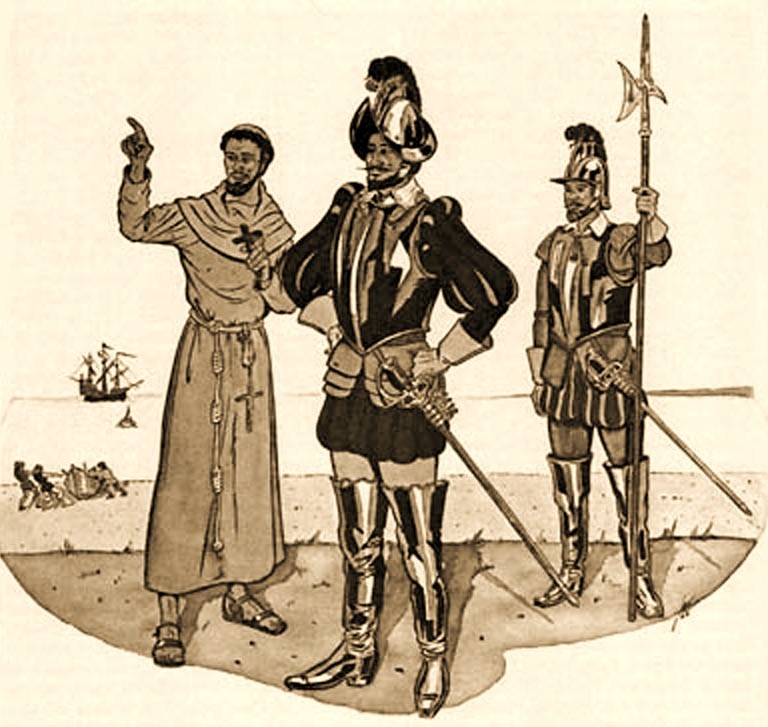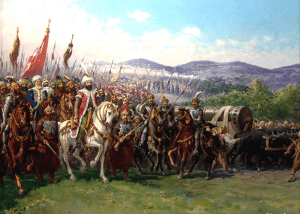Martín de Alarcón, a Spanish sailor, thrived in the world of the Spanish military. The Spanish crown appointed him to protect the country in the vast open waters of the ocean. The smell of sea salt and the decrepit wood under his fingers led people to believe he would live an adventurous life. He is remembered today not as a sailor but as the leader of the expedition that created San Antonio, Texas.1

Martín de Alarcón began his military career as a sailor for the Spanish royal navy in the mid-1600s. He traveled on long treacherous voyages to far off lands throughout the world. On one voyage, Alarcón found his way to the Indies, an important hub for the Spanish during this time. While based in Oran, which today is in North Africa, Alarcón became a seasoned sailor. Alarcón wished to surpass the rest of his shipmates, and so he decided to climb the ranks of the military. He wanted to be more than a mere one of many. Unbeknownst to Alarcón, the next chapter of his life would launch his legendary role as a major player in the rise of the San Antonio de Valero Mission and the town of San Antonio.2
In May of 1691, the Viceroy (a leader of a colony under the rule of a monarchy) of Mexico, Conde de Galve saw promise in Alarcón and appointed him Sargento mayor (Sergeant Major) of Guadalajara. Becoming Sargento mayor was Alarcón’s first step toward joining the upper ranks of the Royal Navy. A few years later, after proving his competency, Viceroy Conde de Galve promoted Alarcón to alcalde mayor (the chief magistrate of a colony or territory) as well as Capitan De Guerra (captain of war) in the areas of Mexico now called the Michoacán.3
In September of 1696, only five years after his first major appointment, Viceroy Juan de Ortega y Montanez appointed Martín de Alarcón to be Capitan De Guerra in the surroundings of Mazapil. His orders as protector of the Royal Spanish military and its citizens had now grown exponentially as he became the protector of Indians. Using his military training and skills he learned through the years as a leader guided him in his endeavors with Indians in the Indies and later the Americas.4

For years, Martín de Alarcón continued in these roles in the dangerous and exciting places at the northern frontier of the Spanish Americas. He used his experiences to explore the New World and protect the Spanish citizens from attacks as the delegated protector of Indian peoples. Through these interactions, he saw the Native groups as a threat and as such treated them with malice.5 This would be most evident during the Alarcón Expedition when he traveled his newly delegated land interacted with the Native peoples that were used to working with the French. This would be a tough task for any leader of what would become San Antonio.6
All of his hard work and years of leadership came to a head in December of 1716 when Alarcón was appointed Commander of the Presidio San Francisco de Coahuila and also became the governor of the Texas province. This appointment was given under the rule of the Viceroy Marques de Valero of Mexico City. His first order of business in his new position was to resupply the Spanish citizens who ventured out into the dangerous terrain of the uncolonized Texas territory. Under the command of Domingo Ramon, many Spaniards ventured into the Texas territory in 1716. This major adventure into the northern frontier of the Texas territory would become Alarcón’s last major step before his life-changing meeting with Father Antonio San Buenaventura y Olivares.7
In 1716, Alarcón finally reached the peak of his career when he traveled to meet with Domingo Ramon’s group of Spaniards in what is called the Alarcón Expedition. He was stopped when he was asked to investigate a man named Louis Juchereau de St. Denis when Alarcón arrived in Saltillo. St. Denis was a Frenchmen working in the same area as Alarcón. Before meeting Alarcón, St. Denis already established multiple successful missions. Alarcón investigated St. Denis for trading illegal goods in the Spanish territory after his earlier arrests. St. Denis was received and accepted after his marriage to the granddaughter of Commander Domingo Ramon. The same man who placed him under house arrest during his time while being investigated by the Spanish crown. Alarcón was asked to investigate St. Denis further during Denis’ second expedition into the Texas frontier. After that, the cooperation between the French and Spanish was destroyed.8

Reporting his findings and after months of delays due to St. Denis, Alarcón continued his adventure into the vast wilderness of the Texas frontier. The Alarcón Expedition is not known for this major delay, but rather for when he met Father Antonio de Olivares. Father Olivares was the missionary who founded the San Antonio de Valero mission. Over six months later, Alarcón crossed the Rio Grande river with several Spaniards who were looking to create a new life in the abundant and healthy soil of the vast new world.
Other than Father Olivares, Martín de Alarcón brought 35 soldiers and approximately ten of them brought their families to the new territory. All together these soldiers and their families totaled around 70 people. All had to take what little belongings they had and put all their faith in Alarcón and 35 soldiers for protection. The trek to their new home was grueling with long days in the heat of a Texas summer. Having very few cattle for transportation, many people had to walk some of the way. Families knew very little of where they are going, and once they do settle their new homeland there would be nothing. After the long and arduous journey, the tired and fatigued settlers faced the realization that their problems and difficulties would only be halfway done. There would be no homes and no crops to feed their families. The only food was that which each settler brought with them. All the supplies to begin building a home had to be found and made. With very little wood around, many of the original buildings were made with hardened soil and stone. All looked up to Alarcón for guidance, leadership, and protection. 9

Father Antonio San Buenavista y Olivares established the San Antonio de Valero Mission, while Martín de Alarcón established the presidio of San Antonio de Bexar. With these newly established areas, the settlers began building around the new markers of the colony, one of these is the Villa de Bexar, one of the most important settlements for the Spanish crown in the Texas territory. This marked the beginning of San Antonio as we know it today. After Alarcón established this new settlement, he left the settlers to begin their new lives as Spanish Texans.
Martín de Alarcón, weary of years on the Texas frontier, finally completed his expedition into the rough and dangerous terrain of the new world. Unlike the settlers that followed him, Alarcón’s travels were far from over. Alarcón continued his mission by visiting the other established colonies. Alarcón traveled to the other missions that were already established by St. Denis before his expedition. In the cold winter months of Texas, Alarcón traveled through the harsh terrain, where he captured and seized illegal trading goods in the name of the Spanish crown. In January of 1719, after many months, Martín de Alarcón took the long path back to San Antonio and saw his colony had survived his departure and the settlers were making it through the winter season. After having served his country for over thirty years, Martín de Alarcón wrote a brief of his findings and sent it to his superiors. It was only then that at the end of that same year Martín de Alarcón was relieved from the charge and burden of being the Governor of Texas. His patriotism and service to the Spanish military were recognized two years later. His records of merits and acknowledgments were filed in 1721 and can be seen in Mexico City.10
Martín de Alarcón was a man who had his faults when it came to cooperation and creating relationships with the Native peoples of the Texas frontier. Yet, he became an impressive leader for his country and his fellow soldiers to admire and hold in esteem. Alarcón led a long life of adventure and risk in the vast reaches of the Spanish territories, all while continuing to be loyal to the Spanish crown and his fellow countrymen.11
- “Spanish Texas,” June 15, 2010, https://tshaonline.org/handbook/online/articles/nps01. ↵
- Donald E. Chipman, “Martín de Alarcón,” Texas Historical Association, Accessed Feb. 2019. https://tshaonline.org/handbook/online/articles/fal02. ↵
- U. S. Coast and Geodetic, “United States Coast and Geodetic Survey, to the Secretary of Commerce,” Annual Report of the Director, 1885. ↵
- “Governor Martin de Alarcon in East Texas – Texas Historical Markers,” Texas Historical Commission. Accessed January 21, 2019. http://www.waymarking.com/gallery/image.aspx?f=1&guid=67408f6a-7a95-401a-bfac-0fd2c194780c&gid=3 ↵
- Carol Lipscomb, “Comanche Indians,” Texas Historical Association, Accessed March 2019. https://tshaonline.org/handbook/online/articles/bmc72. ↵
- Betty Gerald, Comanche Society: Before the Reservation (College Station: Texas A & M Univ Press, 2005). ↵
- Donald E. Chipman, “Martín de Alarcón,” Texas Historical Association, Accessed Feb. 2019. https://tshaonline.org/handbook/online/articles/fal02. ↵
- “St. Denis, Louis Juchereau de,” The Handbook of Texas Online, Texas State Historical Association (TSHA). Accessed January 21, 2019. https://tshaonline.org/handbook/online/articles/fst01. ↵
- John Malcolm Penn, “Landmark Adventures: Hernando de Alarcon,” Landmark Adventures, Accessed March 2019. http://landmarkadventures.blogspot.com/2011/02/hernando-de-alarcon.html. ↵
- “St. Denis, Louis Jucherau de,” The Handbook of Texas Online. Texas State Historical Association (TSHA).” Accessed January 21, 2019. https://tshaonline.org/handbook/online/articles/fst01. ↵
- John Malcolm Penn, “Landmark Adventures: Hernando de Alarcon,” Landmark Adventures, Accessed March 2019. http://landmarkadventures.blogspot.com/2011/02/hernando-de-alarcon.html. ↵



40 comments
Brandon Torres
Although I took the course “Texas History” in middle school, I am very surprised I never heard anything about this man! His story of rising through the ranks and eventually leading in his military career really stood out! Also, his interactions with Father Antonio San Buenaventura y Olivares are some that really stray away from any boring situations! I feet that through these interactions, the understanding of both men was clear and excellently narrated thanks to our author!
Raul Colunga
As someone born and raised in San Antonio it was interesting to read about my hometown. It is a shame more natives do not know about the founder of our city. San Antonio has an immense amount of history, it was particularly cool to read that not only was Alarcon the founder of San Antonio, but he was also the governor of Texas.
Jose Chaman
This is a really interesting story. It was well-written and it keeps the reader focused. I did not know too much about San Antonio neither Texas, because I am not from here, but I can tell that this article does a great job talking about how Alarcon completed his expedition of the new world. I strongly agree with giving Alarcon more recognition about his discoveries, he definitely contributed to San Antonio’s history.
Alexander Avina
I have never heard this story and I am a San Antonio native. I always enjoy learning more about the city of San Antonio. This was a very interesting story about a very interesting individual. It truly amazes me that this story is not well-known. I had a good time reading this article. I guess it just shows that you can always learn something new. I am glad that I came across this article.
Mauro Bustamante
The fact that the Father Antonio San Buenavista y Olivares established the San Antonio de Valero Mission, while Martín de Alarcón established the presidio of San Antonio de Bexar was a very interesting fact that I didn’t know about. Being born in San Antonio this article was very informative about its history and how it was established and the steps the men took to establish the land, these guys show you that even if you were given the short end of a stick you can still make a difference. The article was well written and very interesting due to its factual history about where I live.
Andrea Degollado
As someone who is new to living in San Antonio I found this article extremely interesting to read. Alarcon is a monumental image to San Antonio and should definetely have more recognition that what he does. Although Alarcon was had his faults when it came to cooperating with the Native people in the Texas frontier , he was an impressive leader for his country.
Thalia Romo
I’ve grown up in San Antonio my whole life and this article was interesting to read because I never thought to research the history of it. Alarcon is a monumental figure not on for San Antonio, but to me, since he posed such a strong character. I feel that although Alarcon was difficult to work with, he was an impressive individual as leader for his country. It’s amazing how he was able to prosper even through such tough conditions.
Courtney Pena
Being new to the city, I think that it is interesting to learn much more about it. I did not know that Martin de Alarcon was a governor of Texas. However, it is unfortunate that he is forgotten in history. The city should have a day dedicated to him or a statue of him so that people can know more about the founder.
Rahni Hingoranee
As a new resident of San Antonio, I think it is interesting to learn more about the town’s history. Until now most all I know comprises the Alamo and its history. Alarcon should definitely have more recognition than he does, which is little to none. I personally had never heard of him until reading this article. Alarcon’s leadership skills are honorable and should be better recognized. He was integral in the founding of the city.
Kaleb Werku
As an out of state student I didn’t know much about San Antonio in the first place so it was cool to learn something that, unfortunately, not that many people know about. Martin had so little but he accomplished so much from his limited resources. This guy shows you that even if you were given the short end of a stick you can still make a difference.